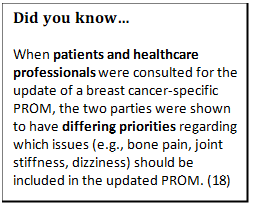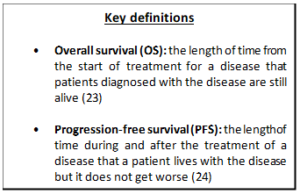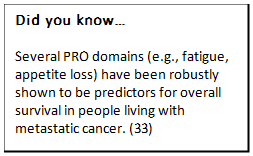October is World Breast Cancer Awareness Month, and 13 October is Metastatic Breast Cancer Awareness Day. Let’s look at how the views of people living with metastatic breast cancer provide a vital, underestimated component of assessing the benefits of novel treatments.
Despite being the subject of immense research efforts, breast cancer remains the second most common cause of death for cisgender women in the US. (1) The majority of these fatalities are due to the development of metastatic disease (cancer that has spread to another part of the body). (2,3) While largely affecting cisgender women, breast cancer affects people of all sexes and genders. (4,5)
Although metastatic breast cancer is incurable and associated with a high symptom burden, (6-8), it can be treated (9) – and the need for optimising metastatic breast cancer care is growing as more and more people live longer with metastatic breast cancer due to advances in therapies. (10) How treatments are best evaluated varies between different types and stages of cancer, and this particularly applies in the case of metastatic disease. In 2020, a multistakeholder steering committee sponsored by Eli Lilly and Company found that some issues relevant to people living with metastatic breast cancer, including patients’ priorities, burden of disease, and metastatic breast cancer-specific quality of life, are “not consistently considered in the current benefit assessment process of new treatments”. (9) While it is always important (and inherent to patient-centred care) to assess treatments in line with the priorities of the people who need them, it is particularly crucial that the needs, wants, and quality of life (QoL) of patients with metastatic breast cancer are considered, given the life-limiting nature of the disease and the unavailability of curative treatment. (11)

Health outcomes are defined as “events occurring as a result of an intervention”, (12) and include examples such as changes in pain or blood pressure. (13) Outcome information is often gathered (‘reported on’) by people working on clinical trials, but data can also be collected in the form of patient-reported outcomes (PROs).
 Collecting PRO data can help researchers, regulators, clinicians, and more to understand how treatments affect patients more comprehensively than solely within traditional dimensions (drug safety and efficacy). Furthermore, if PROMs are chosen/designed in collaboration with patients, drug developers can ensure that treatments are assessed in line with patients’ real priorities. The value of conducting these assessments in clinical trials may be boosted further by the use of disease-specific PROs, (16,17) or even disease stage-specific PROs, which enhance the relevance of the outcomes included – for example, hypothetically, the ability to work may be considered a much less relevant outcome for people living with metastatic breast cancer than those with earlier-stage disease.
Collecting PRO data can help researchers, regulators, clinicians, and more to understand how treatments affect patients more comprehensively than solely within traditional dimensions (drug safety and efficacy). Furthermore, if PROMs are chosen/designed in collaboration with patients, drug developers can ensure that treatments are assessed in line with patients’ real priorities. The value of conducting these assessments in clinical trials may be boosted further by the use of disease-specific PROs, (16,17) or even disease stage-specific PROs, which enhance the relevance of the outcomes included – for example, hypothetically, the ability to work may be considered a much less relevant outcome for people living with metastatic breast cancer than those with earlier-stage disease.
Despite the rich insights PRO data can reveal, many trials do not include PROMs in study design – meaning stakeholders from researchers to patients often lack access to valuable information about novel treatments. Where PROMs are included, regulators often consider the methodology unsound, exacerbating this information gap. Proactive alignment between industry and regulatory bodies is urgently required to ensure PRO data are not collected in vain. (19)
“It is key that…the information collected [through metastatic breast cancer PROMs] is used in a specified analysis, ideally as a secondary endpoint, not simply an exploratory one.”
– Siedman et al. (20)
Regulatory and Health Technology Assessment bodies
Composed correctly, PRO data can help address some common challenges facing organisations that assess the value of new metastatic breast cancer treatments – whether they be regulators, who decide if treatment is safe and effective, or Health Technology Assessment (HTA) agencies, who assess the relative value of treatment within the wider context of ethics, economics, and clinical considerations. (21) PRO data can strengthen drug companies’ submissions to both kinds of organisation, as well inform treatment decisions by clinicians and patients.
For regulators, PRO data can demonstrate efficacy beyond the usual clinical endpoints, which is particularly valuable when a treatment’s efficacy (as defined via traditional measures) is not superior to that of existing products, but that treatment offers patient-relevant benefit that can only be captured via other means (i.e., PRO data collection).
PRO data provide vital context
 For both regulators and HTA bodies, PRO data can help alleviate a common challenge to decision-making regarding new cancer treatments – lack of preferred survival data. (9,22) For these organisations, overall survival (OS) data are preferred over progression-free survival (PFS) data for assessing treatment value. (9,22,25,26) One reason for this is that an improvement in PFS does not consistently translate into an improvement in OS, (22,27-32) and therefore does not necessarily answer the ultimate question of whether a treatment may impact life expectancy.
For both regulators and HTA bodies, PRO data can help alleviate a common challenge to decision-making regarding new cancer treatments – lack of preferred survival data. (9,22) For these organisations, overall survival (OS) data are preferred over progression-free survival (PFS) data for assessing treatment value. (9,22,25,26) One reason for this is that an improvement in PFS does not consistently translate into an improvement in OS, (22,27-32) and therefore does not necessarily answer the ultimate question of whether a treatment may impact life expectancy.
 Given the limitations of PFS data, PRO data can be a particularly useful addition to a treatment’s evidence base when OS data are not available. Indeed, due to the urgency of making novel cancer treatments available, it is common for insufficient time to have passed to facilitate the collection of satisfactorily mature OS data when treatment efficacy or relative value are being assessed. (26) In situations like this, PRO data (which can be collected sooner than those pertaining to OS) can contextualise efficacy with tolerability from patients’ perspectives – a particularly key source of information given that compared to patient reports, clinician-assessed toxicity gradings may miss up to half of adverse events. (34) This helps to support the meaningful evaluation of treatments in lieu of OS data and in conjunction with PFS data. (11,20)
Given the limitations of PFS data, PRO data can be a particularly useful addition to a treatment’s evidence base when OS data are not available. Indeed, due to the urgency of making novel cancer treatments available, it is common for insufficient time to have passed to facilitate the collection of satisfactorily mature OS data when treatment efficacy or relative value are being assessed. (26) In situations like this, PRO data (which can be collected sooner than those pertaining to OS) can contextualise efficacy with tolerability from patients’ perspectives – a particularly key source of information given that compared to patient reports, clinician-assessed toxicity gradings may miss up to half of adverse events. (34) This helps to support the meaningful evaluation of treatments in lieu of OS data and in conjunction with PFS data. (11,20)
QoL data are another source of important context for efficacy data, as QoL is one of the endpoints most valued by people living with metastatic breast cancer. (35) While physicians can collect QoL data from patients, it’s more appropriate to approach QoL as a PRO, as for patients with metastatic breast cancer, substantial variability has been demonstrated between QoL ratings by physicians and those by patients. (36)
“Assessments of the overall benefit of metastatic breast cancer treatments are more valuable when, in addition to factoring in the survival benefit, they are informed by patients’ needs and priorities with respect to health-related quality of life and ability to participate in daily life activities.”
– Cardoso et al. (9)
Clinicians and patients
If OS data are available, given that oncologists must weigh up treatment impact on quality of life as well as survival duration, PRO data can be the key link between proving an improvement to OS is not only statistically significant, but also clinically meaningful. (37) This provides vital, relevant detail to help empower clinicians to differentiate between treatment options and select that which is most appropriate for each individual patient. The same also applies more generally; when efficacy across multiple treatment options is comparable but drug toxicity profiles differ, PRO data can help oncologists to interpret the impact of different treatments on quality of life, symptom burden, and more, and thus make better-informed choices as to which treatment is most suitable for each patient. (38)
Similarly, PRO data are valued by patients, as these results can enhance communication between patients and their clinicians about treatment options and thus empower patients to partake in shared decision-making regarding their care. (39) What’s more, as PRO data can support regulatory and HTA decisions, PRO data have the potential to facilitate a major priority for many patients – having choices as to which treatment(s) they wish to receive.
“PROs can provide valuable information about trade-offs between benefits and adverse events of breast cancer treatments and reduce the burdens from breast cancer symptoms and adverse events of breast cancer treatments simultaneously.”
– Rivera et al. (19)
Where are we now?
Room for improvement: As of 2019, it was apparent that despite the FDA having released guidance on the implementation of PROs in clinical trials ten years prior, there had been minimal change in the use of PROs as endpoints in metastatic breast cancer studies. (40) What’s more, despite the emergence of recommendations for PROMs (e.g., HRQoL questionnaires) to be disease-specific, as of 2021, it remained common in metastatic breast cancer research for more generalised measures to be used instead. (11)
The bright side: the European Organisation for Research and Treatment of Cancer, the European School of Oncology (ESO), and the ABC Global Alliance are currently collaborating to develop an up-to-date, standardised, and patient voice-informed PROM focusing on health-related QoL in metastatic breast cancer. (9,11) This will hopefully result in greater implementation of high-quality PROs in metastatic breast cancer trials and treatment decisions – and ultimately, more patient-centred care for every person living with metastatic breast cancer.
- Prime Patient is a specialist consultancy delivering strategic patient engagement solutions to achieve a triple win for patients, Pharma, and society. For more information, get in touch via PatientEngagement@primeglobalpeople.com.
References
- Breast Cancer Statistics | How Common Is Breast Cancer? [Internet]. Cancer.org. 2022. Available from: https://www.cancer.org/cancer/breast-cancer/about/how-common-is-breast-cancer.html
- Breast Cancer – Metastatic – Statistics [Internet]. Cancer.Net. 2022. Available from: https://www.cancer.net/cancer-types/breast-cancer-metastatic/statistics3.
- Breast Cancer – Metastatic – Introduction [Internet]. Cancer.Net. 2021. Available from: https://www.cancer.net/cancer-types/breast-cancer-metastatic/introduction
- Breast cancer in men – NHS [Internet]. nhs.uk. 2020. Available from: https://www.nhs.uk/conditions/breast-cancer-in-men/
- Resource for transgender and non-binary people | Breast Cancer UK [Internet]. Breast Cancer UK. 2022. Available from: https://www.breastcanceruk.org.uk/about-breast-cancer/resource-for-transgender-and-non-binary-people/
- Breast Cancer – Metastatic – Types of Treatment [Internet]. Cancer.Net. 2021. Available from: https://www.cancer.net/cancer-types/breast-cancer-metastatic/types-treatment
- Hamer J, McDonald R, Zhang L, Verma S, Leahey A, Ecclestone C et al. Quality of life (QOL) and symptom burden (SB) in patients with breast cancer. Supportive Care in Cancer. 2016;25(2):409-419.
- Lloyd A, Nafees B, Narewska J, Dewilde S, Watkins J. Health state utilities for metastatic breast cancer. British Journal of Cancer. 2006;95(6):683-690.
- Cardoso F, Wilking N, Bernardini R, Biganzoli L, Espin J, Miikkulainen K et al. A multi-stakeholder approach in optimising patients’ needs in the benefit assessment process of new metastatic breast cancer treatments. The Breast. 2020;52:78-87.
- Caswell-Jin J, Plevritis S, Tian L, Cadham C, Xu C, Stout N et al. Change in Survival in Metastatic Breast Cancer with Treatment Advances: Meta-Analysis and Systematic Review. JNCI Cancer Spectrum. 2018;2(4).
- Clarijs M, Thurell J, Kühn F, Uyl-de Groot C, Hedayati E, Karsten M et al. Measuring Quality of Life Using Patient-Reported Outcomes in Real-World Metastatic Breast Cancer Patients: The Need for a Standardized Approach. Cancers. 2021;13(10):2308.
- Doan T, Bhattacharya M, Scarazzini L, Renz C, Lievano F. Pharmacovigilance. Elsevier; 2019.
- Outcome Measure Considerations for Clinical Trials Reporting on ClinicalTrials.gov [Internet]. Harvard Catalyst; 2018 [cited 6 October 2022]. Available from: https://catalyst.harvard.edu/wp-content/uploads/regulatory/CTR3_OutcomeMeasures.pdf
- Higgin J, Thomas J, Chandler J, Cumpsto M, Li T, Page M et al. Cochrane Handbook for Systematic Reviews of Interventions [Internet]. Cochrane Training. 2022 [cited 6 October 2022]. Available from: https://training.cochrane.org/handbook/current
- Weldring T, Smith S. Article Commentary: Patient-Reported Outcomes (PROs) and Patient-Reported Outcome Measures (PROMs). Health Services Insights. 2013;6:HSI.S11093.
- Churruca K, Pomare C, Ellis L, Long J, Henderson S, Murphy L et al. Patient‐reported outcome measures (PROMs): A review of generic and condition‐specific measures and a discussion of trends and issues. Health Expectations. 2021;24(4):1015-1024.
- Cella D, Hahn EA, Jensen SE, et al. Patient-Reported Outcomes in Performance Measurement. Research Triangle Park (NC): RTI Press; 2015 Sep. Types of Patient-Reported Outcomes. Available from: https://www.ncbi.nlm.nih.gov/books/NBK424381/
- Bjelic-Radisic V, Cardoso F, Cameron D, Brain E, Kuljanic K, da Costa R et al. An international update of the EORTC questionnaire for assessing quality of life in breast cancer patients: EORTC QLQ-BR45. Annals of Oncology. 2020;31(2):283-288.
- Hong K, Majercak K, Villalonga-Olives E, Perfetto E. Patient-reported outcomes in breast cancer FDA drug labels and review documents. Journal of Patient-Reported Outcomes. 2021;5(1).
- Seidman A, Maues J, Tomlin T, Bhatnagar V, Beaver J. The Evolution of Clinical Trials in Metastatic Breast Cancer: Design Features and Endpoints That Matter. American Society of Clinical Oncology Educational Book. 2020;(40):44-54.
- Pujolras L, Cairns J. Why do some countries approve a cancer drug and others don’t?. Journal of Cancer Policy. 2015;4:21-25.
- Gutman SI, Piper M, Grant MD, et al. Progression-Free Survival: What Does It Mean for Psychological Well-Being or Quality of Life? [Internet] Rockville (MD): Agency for Healthcare Research and Quality (US); 2013 Apr. Background. Available from: https://www.ncbi.nlm.nih.gov/books/NBK137763/
- NCI Dictionary of Cancer Terms [Internet]. National Cancer Institute. [cited 6 October 2022]. Available from: https://www.cancer.gov/publications/dictionaries/cancer-terms/def/overall-survival
- NCI Dictionary of Cancer Terms [Internet]. National Cancer Institute. [cited 6 October 2022]. Available from: https://www.cancer.gov/publications/dictionaries/cancer-terms/def/progression-free-survival
- Smith N, Fu A, Fisher T, Meletiche D, Pawar V. Oncology drugs and added benefit: insights from 3 European health technology assessment agencies on the role of efficacy endpoints. Journal of Medical Economics. 2021;25(1):1-6.
- Lux M, Ciani O, Dunlop W, Ferris A, Friedlander M. The Impasse on Overall Survival in Oncology Reimbursement Decision-Making: How Can We Resolve This?. Cancer Management and Research. 2021;Volume 13:8457-8471.
- Cortazar P, Zhang J, Sridhara R, Justice R, Pazdur R. Relationship between OS and PFS in metastatic breast cancer (MBC): Review of FDA submission data. Journal of Clinical Oncology. 2011;29(15_suppl):1035-1035.
- Adunlin G, Cyrus J, Dranitsaris G. Correlation between progression-free survival and overall survival in metastatic breast cancer patients receiving anthracyclines, taxanes, or targeted therapies: a trial-level meta-analysis. Breast Cancer Research and Treatment. 2015;154(3):591-608.
- Belin L, Tan A, De Rycke Y, Dechartres A. Progression-free survival as a surrogate for overall survival in oncology trials: a methodological systematic review. British Journal of Cancer. 2020;122(11):1707-1714.
- Michiels S, Pugliano L, Marguet S, Grun D, Barinoff J, Cameron D et al. Progression-free survival as surrogate end point for overall survival in clinical trials of HER2-targeted agents in HER2-positive metastatic breast cancer. Annals of Oncology. 2016;27(6):1029-1034.
- Gyawali B, Hey S, Kesselheim A. Evaluating the evidence behind the surrogate measures included in the FDA’s table of surrogate endpoints as supporting approval of cancer drugs. EClinicalMedicine. 2020;21:100332.
- Burzykowski T, Buyse M, Piccart-Gebhart M, Sledge G, Carmichael J, Lück H et al. Evaluation of Tumor Response, Disease Control, Progression-Free Survival, and Time to Progression As Potential Surrogate End Points in Metastatic Breast Cancer. Journal of Clinical Oncology. 2008;26(12):1987-1992.
- Efficace F, Biganzoli L, Piccart M, Coens C, Van Steen K, Cufer T et al. Baseline health-related quality-of-life data as prognostic factors in a phase III multicentre study of women with metastatic breast cancer. European Journal of Cancer. 2004;40(7):1021-1030.
- Lai-Kwon J, Yin Z, Minchom A, Yap C. 585P Trends in patient-reported outcome (PRO) use in early phase oncology trials. Annals of Oncology. 2020;31:S495.
- Mertz S, Benjamin C, Girvalaki C, Cardone A, Gono P, May S et al. Progression-free survival and quality of life in metastatic breast cancer: The patient perspective. The Breast. 2022;65:84-90.
- Wilson, K.A., Dowling, A.J., Abdolell, M. et al. Perception of quality of life by patients, partners and treating physicians. Qual Life Res 9, 1041–1052 (2000). https://doi.org/10.1023/A:1016647407161
- Hutchinson L. Survival benefit and quality of life. Nature Reviews Clinical Oncology. 2015;12(4):189-189.
- Cardoso F, Senkus-Konefka E, Fallowfield L, Costa A, Castiglione M. Locally recurrent or metastatic breast cancer: ESMO Clinical Practice Guidelines for diagnosis, treatment and follow-up. Annals of Oncology. 2010;21:v15-v19.
- Cruz Rivera S, Mercieca-Bebber R, Aiyegbusi O, Scott J, Hunn A, Fernandez C et al. The need for ethical guidance for the use of patient-reported outcomes in research and clinical practice. Nature Medicine. 2021;27(4):572-573.
- Gaulin C, Osorio G. Patient Reported Outcomes in Metastatic Breast Cancer Studies: Evaluating the Impact of the FDA Guidance for Industry. Journal of Scientific Innovation in Medicine. 2019;2(1).




